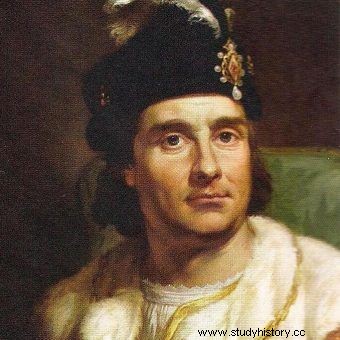
Jan Olbracht in Marcello Bacciarelli's portrait.
Jan Olbracht (1459-1501) - the king of Poland in the years 1492-1501, from the Jagiellonian dynasty. He was the third son of Kazimierz IV Jagiellończyk and Elżbieta Rakuszanka. He was born on December 27, 1459 in Krakow. He was educated by Jan Długosz and Filip Buonaccorsiego (Kallimach). From 1484, after the death of his older brother, Prince Kazimierz, he was prepared by his father to take over the Polish throne. In 1490, he briefly competed with his brother Władysław for the Hungarian throne. After the loss, he received Głogów as compensation, where he held the duke's power from 1491 to 1498.
After the death of Kazimierz IV, he competed for the Polish crown with his brothers and Janusz II, the Duke of Płock. He won thanks to the support of his mother, as well as the nobility and the middle class. His coronation took place on September 30, 1492 in Krakow. Power in Lithuania fell to his younger brother, Aleksander Jagiellończyk. In the first years of his rule, Jan managed to join the Duchy of Zator and Płock. He also concluded with his brother in 1499 a new Polish-Lithuanian union in Vilnius.
As the king of Poland, he significantly strengthened the position of the nobility. In 1493, he limited the right of peasants to move, and in 1496 he issued Piotrków privileges, which gave the nobility exclusive access to church dignities. At the same time, he forbade the townspeople to acquire landed goods.
Jan strove to subordinate Moldova to Poland, which was in the orbit of Turkish influence. In 1497, he organized an expedition to recover Kilia and Białogród. Perhaps he also planned to place his brother, Sigismund, on the Moldavian throne. The intervention ended in complete failure, and the king suffered a severe defeat at Koźmin during his retreat, which gave rise to the saying: The nobility died under King Olbracht . The aftermath of the tightening of relations with Turkey was the Turkish invasion of 1498.
He led a boisterous lifestyle - he liked to eat well, live comfortably and find new entertainment for himself. He never married, but had many lovers. Most likely, it was from them around 1497 that he contracted the disease that eventually led to his death (it is suspected that he may have died from syphilis). He died on June 17, 1501 in Toruń, where he was preparing for a war with the Teutonic Knights who had begun to question the terms of the Toruń peace of 1466 a few years earlier.
